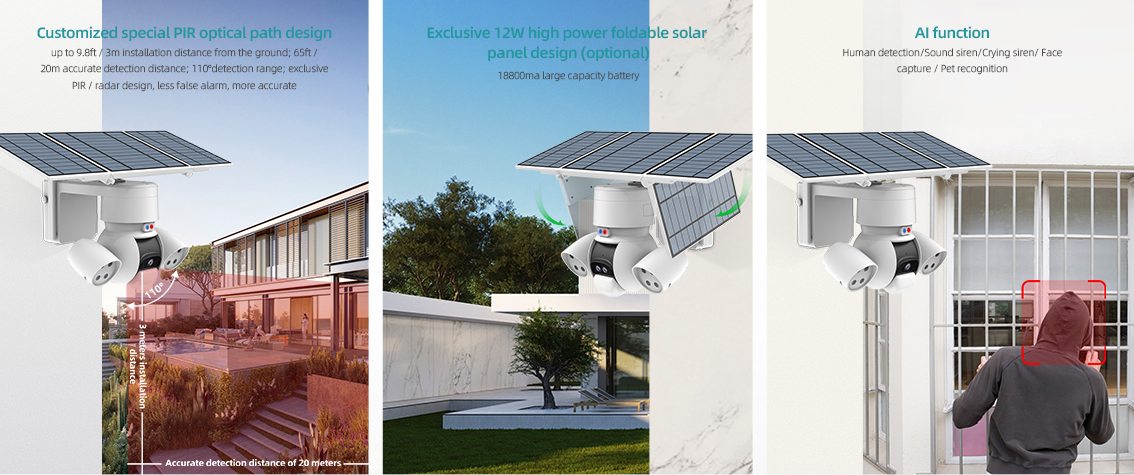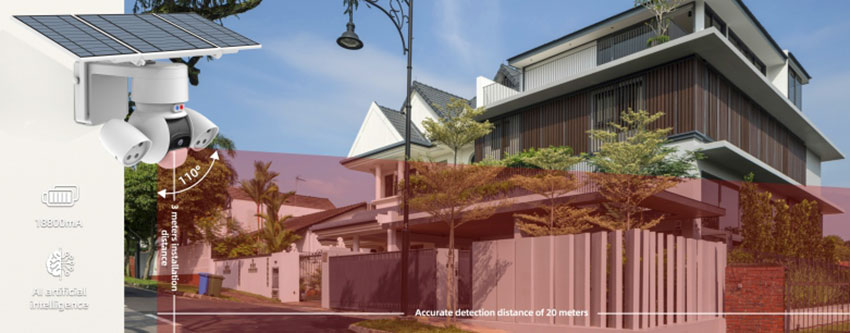
Tuya solar powered security cameras, how it works?
When security cameras need to work in outdoor condition, there are two necessary requirements; there is power supply for the camera, there is network exists for data transmission. IP cameras can transmit video signal through wired Ethernet cable (e.g. cat5e, fiber), wireless (4G LTE, 5G, Wi-Fi, or Access Point). For the power supply, users can consider use solar panel + battery solution. Under some difficult conditions like no power, no Wi-Fi, using solar powered 4G LTE security camera is a good choice.
As reducing carbon emission concept has been widely accepted by mass population, as one of most important renewable energy, solar panel has been used in a wide range of application. In video surveillance industry, utilizing solar power enables people to deploy completely wire-free video surveillance system, installation is more flexible and convenient, for the long run it can save cost.
Comparing to the conventional security cameras, solar powered security cameras has three main features including low power consumption, solar panel design, built-in rechargeable battery, we’re going to discuss these three features in details.
Low power consumption
Using solar panel + rechargeable battery, the camera design has to consider the power consumption, this very important factor. Though it’s the job what the engineers need to do and has no direct correlation with end-users, knowing this helps end-users to select right product for their applications.
When security camera is operating, the power consumption varies from working status. For instance, when camera is working in normal, standby, night vision, PTZ, video recording, the power consumption is different. Solar panel + battery has limited capacity, can’t work like the way as the conventional cameras do. Henceforth, it’s crucial important to reduce power consumption when cameras work under different status. Generally, the solar powered security cameras work under status can be divided into three modes: standby (ultra low power), low power consumption, full power consumption.

Standby (ultra low power)
Under this status, security camera stops all basic functions (remote access/view, local video recording), only keeps the network connection, camera imaging system is in sleep status, the average power consumption is approximately 400mW – 700mW.
Low Power Consumption
End-users can wake up the camera through the app, or built-in motion sensor (Passive Infrared sensor, doppler radar) to wake up the camera, the camera will enter into working status.
Remote viewing of real-time video requires continuous network connection (Wi-Fi or 4G LTE), security camera is in working status, the power consumption increases. However, if there is no remote access, the camera keeps in standby mode. When abnormal activity occurs in monitored area, if there is no TF memory card video recording, NVR video recording and cloud storage, then it becomes useless to deploy the cameras. To solve this problem is very simple, adding intrusion detecting sensor that helps camera to detect abnormal activity and wakes up to record the video and send push notifications simultaneously.

Considering the requirement of low power consumption, the human movement sensor is usually a Passive infrared motion sensor or microwave doppler radar. Some cameras may adopt PIR + microwave dual motion sensors design to enhance the accuracy of motion detection.
Most of time, the solar powered camera is in standby mode, when users access the camera through smartphone remotely or human detection occurs, camera will wake up and enter into working status. When remote accessing is disconnected or a period of time after alarm, the camera will re-enter into standby status, wait for next wake up. It should be noted that, under low power mode, camera cannot be set to record video continuously or by schedule, only support motion detection recording.
Full Power Consumption
Full power is a relative concept when comparing to low power, it means the camera works as the way conventional cameras do. Under full power mode, all functions can be enabled and used by users.
Solar Panel
A solar panel converts sunlight into electricity, the electricity can be used for the operation of camera in the day time and recharge the battery. Solar panel has up to 25 years lifespan and conversion rate is about 20%.
Battery
Solar panel powered security cameras usually utilize 18650 or 21700 type rechargeable Lithium battery, the maximum capacity for 18650 battery can not exceed 3400mAH, a single 21700 battery can support 5000mAH capacity. The voltage is 3.7V, however security cameras work with 5V or 12V, which can be supplied by using multiple batteries connected in series or in parallel. For example, one solar panel powered security camera uses a battery pack consist of 6 pieces 18650 battery, the maximum capacity reaches 20000mAH/3.7V.
Professional solar powered security camera usually use lead acid battery, as its cost is much lower than using 18650 Lithium battery, while the capacity is larger. Unlike light weight 18650 batteries, Lead-acid battery is heavy, not suitable for products in consumer market.
We supply solar powered PTZ dome camera powered by Tuya IoT platform. The new product portfolio can work with TuyaSmart and Smart Life app. In addition to remote viewing and video recording, our Tuya solar powered security cameras have embedded AI algorithm can support advanced face detection, face capturing, pet recognition, motion detection, sound detection, crying detection..etc useful features to let you have a truly smart camera system.
Scan me




